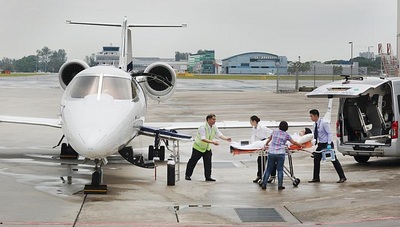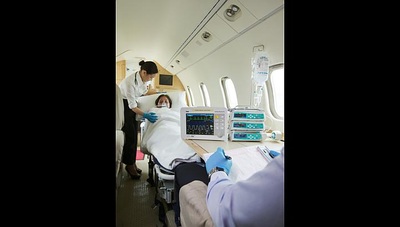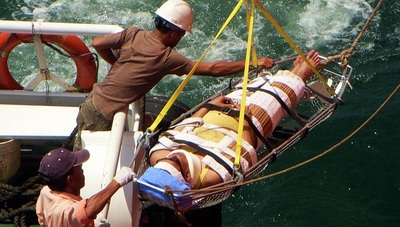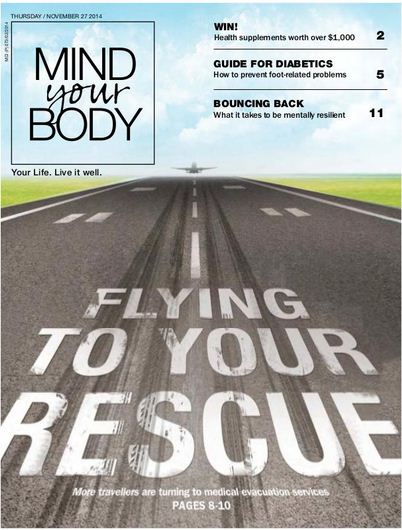
Travel Insurance and Medical evacuation
This resource is a collection of articles published in Mind your body by the Straits Times on 27 Nov 2014. There a a total of 4 articles
1. Get peace of mind when you travel By Poon Chian Hui
When you plan for a holiday, having an accident or health emergency abroad is unlikely to be something which you would dwell on too much.
The bigger worry might be on getting your itinerary, transport and accommodation sorted out in time. For me, buying travel insurance - I usually get the per trip type - is often at the bottom of my list. I do that usually just a few days before I fly. Usually, I just go for the classic plan, without any add-ons.
My biggest fear when I travel is losing my luggage and that plan adequately covers it. It is probably not the wisest move, especially for trips which involve a degree of adventure and, therefore, risk. Mountain-climbing, rafting, bungee-jumping, taking helicopter or hot-air balloon rides and skiing are some popular activities for travellers these days, and are sometimes included in tour packages. However, you can find yourself in a pickle if you hurt yourself or suffer a medical emergency, such as a heart attack, while abroad, only to realise that your travel insurance does not cover such incidents. If you are travelling more often than before, it may be high time to pay more attention to getting the insurance coverage which suits you and your family's needs. And it's not as troublesome as it appears to be. First of all, many travel insurance plans can be bought online with a credit card, including annual plans. You don't always have to get it directly from insurance companies if you are not familiar with them. I discovered recently that my bank offers travel insurance too, under a tie-up with an insurance company. And yes, it has been updated to include adventure sports. There is also a new plan on the list, which states it is ideal for "unforeseen situations", such as injuries and illness. I think I shall give that a try the next time I go on an adventure holiday, even if it's just for a better peace of mind.
2. Crossing borders in search of the best By Joan Chew
Demand for medical evacuation services is growing as more people travel and affluent patients look beyond their shores for treatment
During a guided tour in China, Mrs Tan came out of the bathroom one morning and found her husband slumped on the hotel room floor. At first, she thought he had fainted because of a lack of oxygen, as they were in high-altitude Shangri- La County. She quickly gave the 60-year-old deliveryman some oxygen from a portable canister, but realised his condition was more serious than she first thought as he could not move the left side of his body. When she alerted the rest of the tour group, it was after 6am. By noon, Mr Tan finally arrived at Lijiang People's Hospital in the neighbouring city. Medical tests showed that he had suffered an ischaemic stroke, where blood flow to the brain is obstructed by a clot. His 36-year-old son, a project manager, arrived in Shangri-La two days later, on Nov 8. That day, Mr Tan's travel insurance company alerted a team at Express Medical Assistance (EMA) Global. Dr Winston Jong, founder and medical director of the medical evacuation company, assessed Mr Tan's condition and advised that it was best for him to continue his treatment in Singapore as stroke patients have a long recovery period. Mr Tan's condition was stable, but he was hooked up to a few medical machines - a ventilator to assist his breathing and a suction machine to remove secretions from his lungs, among others - so it was impractical to fly home commercially. Furthermore, such a trip would involve a layover at Shangri-La. So a chartered aircraft from EMA Global took off from Seletar Airport in Singapore at 6.30am on Nov 10. At 11am, it landed in Lijiang and Mr Tan was transferred onto the aircraft, accompanied by his son, a general practitioner and a nurse trained in intensive care. By 10pm, he was at Singapore General Hospital, where he remains. The younger Mr Tan, who is the eldest of three children, said: "It was a relief to see someone from home come to pick up my dad."
AFFLUENCE DRIVING DEMAND
In recent years, medical evacuation (medivac) companies have seen higher demand for their services, which focus on preparing, monitoring, treating and caring for patients to be transported by air. These patients usually require advanced medical care that a commercial airline's crew cannot provide. They may be ventilator-dependent or have multiple physical injuries. Some may even be babies with congenital conditions. An air ambulance is activated when the medical facilities in a country in which a patient is in cannot adequately treat him, or if his family members prefer to have him treated elsewhere. At least four medivac providers said Indonesia remains a major source of patients evacuated here. Mr Prithpal Singh, chief executive officer of Executive Jets Asia Group, which has a medical evacuation subsidiary called Flying Doctors Asia (FDA), said they used to conduct between five and 10 evacuations a month. That was about a decade ago. These days, FDA attends to at least one evacuation a day, with its jets flying further, to places such as Mongolia and Russia.
Mr Singh attributed the rise to more well-heeled travellers buying travel insurance which covers the costs of such evacuations. Rising affluence also gives people the means to seek renowned doctors and medical facilities in other countries, he added. After all, the service is not cheap. A trip in an air ambulance from Bali to Singapore costs $35,000, while a Maldives to Singapore route can set one back by $55,000, he said. The cost of the evacuation depends on the specialist medical team and the type of equipment and medicine required. It may be covered by travel insurance, depending on the terms of the policy purchased. Mr Ignatius Chng, who heads travel insurance and related services at insurer AIG, said an evacuation from Jiangsu, China, to Singapore starts from US$80,000 (S$104,000), while one from New Zealand to Singapore can start from US$180,000. High-altitude sickness is the top reason for medical evacuations activated by AIG in Asia-Pacific, he said. This comes as more travellers are heading to exotic mountainous locations in the region. This is followed by personal accidents and motor vehicle accidents. Medivac by taxi boats is also becoming common. Last month, Parkway Shenton started its new Maritime Medical Services to help ill seafarers, who are mostly from merchant vessels and do not have access to doctors onboard. Dr Ravin Nair, assistant clinical director of emergency services in Parkway Shenton, said injuries from falls and heart attacks are the two most common reasons his team is activated for. They, sometimes, have to use cranes to move patients lying on stretchers from a big vessel to their taxi boat, which then takes them back to land to a waiting ambulance.
PLANS TO EXPAND
Dr Jong estimated that the six jets used by EMA Global now fly a total of 1,000 hours a year, up from 600 hours five years ago. All these flights take off from Singapore. This is set to increase, as the company now services regions beyond Asia-Pacific, such as Europe and Latin and Central America. This expansion came about through a partnership with Assist Card International - a provider of travel and medical assistance in more than 107 countries - which was announced in September. The partnership gives EMA Global a combined network of more than 400,000 medical providers, medical facilities, air and road ambulances. Its new corporate membership programme aims to take a more pre-emptive approach in meeting one's overseas medical needs too.
This is done by providing members with pre-trip medical advice and collecting their medical information beforehand, so that treatment can be smoother and faster in the event of an emergency.
Parkway Shenton's clinical director of emergency services, Dr Tan Seow Hwee, said Singapore is facing stiffer competition from neighbouring countries, such as India, Malaysia and Thailand, which are building up their medical tourism sectors. He said the strong Singapore dollar also makes these countries more cost-competitive. But Singapore remains the "go-to" place for complex cases, such as multi-organ failure patients, who require treatment from different types of specialists. Sometimes, however, medivac providers do assess that it is not worth the risk to transport a patient to another location, and have had to convince family members to let them be treated where they are. One such case was that of an elderly man who had a massive blood clot in the brain. His family members wanted him to be operated on in Singapore, recalled Dr Ravin. But brain surgery has to be done as quickly as possible and flying him here from Jakarta, Indonesia, would have taken too long and increased his risk of brain damage, which could turn fatal. Dr Ravin managed to change the family members' minds and the medivac mission was called off. "We want to give patients and their families a fighting chance, but we do not want to put patients under unnecessary risks," he said.
This resource is a collection of articles published in Mind your body by the Straits Times on 27 Nov 2014. There a a total of 4 articles
- Get peace of mind when you travel
- Crossing borders in search of the best
- Evacuations to Singapore
- What to consider when buying travel insurance
1. Get peace of mind when you travel By Poon Chian Hui
When you plan for a holiday, having an accident or health emergency abroad is unlikely to be something which you would dwell on too much.
The bigger worry might be on getting your itinerary, transport and accommodation sorted out in time. For me, buying travel insurance - I usually get the per trip type - is often at the bottom of my list. I do that usually just a few days before I fly. Usually, I just go for the classic plan, without any add-ons.
My biggest fear when I travel is losing my luggage and that plan adequately covers it. It is probably not the wisest move, especially for trips which involve a degree of adventure and, therefore, risk. Mountain-climbing, rafting, bungee-jumping, taking helicopter or hot-air balloon rides and skiing are some popular activities for travellers these days, and are sometimes included in tour packages. However, you can find yourself in a pickle if you hurt yourself or suffer a medical emergency, such as a heart attack, while abroad, only to realise that your travel insurance does not cover such incidents. If you are travelling more often than before, it may be high time to pay more attention to getting the insurance coverage which suits you and your family's needs. And it's not as troublesome as it appears to be. First of all, many travel insurance plans can be bought online with a credit card, including annual plans. You don't always have to get it directly from insurance companies if you are not familiar with them. I discovered recently that my bank offers travel insurance too, under a tie-up with an insurance company. And yes, it has been updated to include adventure sports. There is also a new plan on the list, which states it is ideal for "unforeseen situations", such as injuries and illness. I think I shall give that a try the next time I go on an adventure holiday, even if it's just for a better peace of mind.
2. Crossing borders in search of the best By Joan Chew
Demand for medical evacuation services is growing as more people travel and affluent patients look beyond their shores for treatment
During a guided tour in China, Mrs Tan came out of the bathroom one morning and found her husband slumped on the hotel room floor. At first, she thought he had fainted because of a lack of oxygen, as they were in high-altitude Shangri- La County. She quickly gave the 60-year-old deliveryman some oxygen from a portable canister, but realised his condition was more serious than she first thought as he could not move the left side of his body. When she alerted the rest of the tour group, it was after 6am. By noon, Mr Tan finally arrived at Lijiang People's Hospital in the neighbouring city. Medical tests showed that he had suffered an ischaemic stroke, where blood flow to the brain is obstructed by a clot. His 36-year-old son, a project manager, arrived in Shangri-La two days later, on Nov 8. That day, Mr Tan's travel insurance company alerted a team at Express Medical Assistance (EMA) Global. Dr Winston Jong, founder and medical director of the medical evacuation company, assessed Mr Tan's condition and advised that it was best for him to continue his treatment in Singapore as stroke patients have a long recovery period. Mr Tan's condition was stable, but he was hooked up to a few medical machines - a ventilator to assist his breathing and a suction machine to remove secretions from his lungs, among others - so it was impractical to fly home commercially. Furthermore, such a trip would involve a layover at Shangri-La. So a chartered aircraft from EMA Global took off from Seletar Airport in Singapore at 6.30am on Nov 10. At 11am, it landed in Lijiang and Mr Tan was transferred onto the aircraft, accompanied by his son, a general practitioner and a nurse trained in intensive care. By 10pm, he was at Singapore General Hospital, where he remains. The younger Mr Tan, who is the eldest of three children, said: "It was a relief to see someone from home come to pick up my dad."
AFFLUENCE DRIVING DEMAND
In recent years, medical evacuation (medivac) companies have seen higher demand for their services, which focus on preparing, monitoring, treating and caring for patients to be transported by air. These patients usually require advanced medical care that a commercial airline's crew cannot provide. They may be ventilator-dependent or have multiple physical injuries. Some may even be babies with congenital conditions. An air ambulance is activated when the medical facilities in a country in which a patient is in cannot adequately treat him, or if his family members prefer to have him treated elsewhere. At least four medivac providers said Indonesia remains a major source of patients evacuated here. Mr Prithpal Singh, chief executive officer of Executive Jets Asia Group, which has a medical evacuation subsidiary called Flying Doctors Asia (FDA), said they used to conduct between five and 10 evacuations a month. That was about a decade ago. These days, FDA attends to at least one evacuation a day, with its jets flying further, to places such as Mongolia and Russia.
Mr Singh attributed the rise to more well-heeled travellers buying travel insurance which covers the costs of such evacuations. Rising affluence also gives people the means to seek renowned doctors and medical facilities in other countries, he added. After all, the service is not cheap. A trip in an air ambulance from Bali to Singapore costs $35,000, while a Maldives to Singapore route can set one back by $55,000, he said. The cost of the evacuation depends on the specialist medical team and the type of equipment and medicine required. It may be covered by travel insurance, depending on the terms of the policy purchased. Mr Ignatius Chng, who heads travel insurance and related services at insurer AIG, said an evacuation from Jiangsu, China, to Singapore starts from US$80,000 (S$104,000), while one from New Zealand to Singapore can start from US$180,000. High-altitude sickness is the top reason for medical evacuations activated by AIG in Asia-Pacific, he said. This comes as more travellers are heading to exotic mountainous locations in the region. This is followed by personal accidents and motor vehicle accidents. Medivac by taxi boats is also becoming common. Last month, Parkway Shenton started its new Maritime Medical Services to help ill seafarers, who are mostly from merchant vessels and do not have access to doctors onboard. Dr Ravin Nair, assistant clinical director of emergency services in Parkway Shenton, said injuries from falls and heart attacks are the two most common reasons his team is activated for. They, sometimes, have to use cranes to move patients lying on stretchers from a big vessel to their taxi boat, which then takes them back to land to a waiting ambulance.
PLANS TO EXPAND
Dr Jong estimated that the six jets used by EMA Global now fly a total of 1,000 hours a year, up from 600 hours five years ago. All these flights take off from Singapore. This is set to increase, as the company now services regions beyond Asia-Pacific, such as Europe and Latin and Central America. This expansion came about through a partnership with Assist Card International - a provider of travel and medical assistance in more than 107 countries - which was announced in September. The partnership gives EMA Global a combined network of more than 400,000 medical providers, medical facilities, air and road ambulances. Its new corporate membership programme aims to take a more pre-emptive approach in meeting one's overseas medical needs too.
This is done by providing members with pre-trip medical advice and collecting their medical information beforehand, so that treatment can be smoother and faster in the event of an emergency.
Parkway Shenton's clinical director of emergency services, Dr Tan Seow Hwee, said Singapore is facing stiffer competition from neighbouring countries, such as India, Malaysia and Thailand, which are building up their medical tourism sectors. He said the strong Singapore dollar also makes these countries more cost-competitive. But Singapore remains the "go-to" place for complex cases, such as multi-organ failure patients, who require treatment from different types of specialists. Sometimes, however, medivac providers do assess that it is not worth the risk to transport a patient to another location, and have had to convince family members to let them be treated where they are. One such case was that of an elderly man who had a massive blood clot in the brain. His family members wanted him to be operated on in Singapore, recalled Dr Ravin. But brain surgery has to be done as quickly as possible and flying him here from Jakarta, Indonesia, would have taken too long and increased his risk of brain damage, which could turn fatal. Dr Ravin managed to change the family members' minds and the medivac mission was called off. "We want to give patients and their families a fighting chance, but we do not want to put patients under unnecessary risks," he said.
3. Evacuation to Singapore
Dr Winston Jong, medical director of Express Medical Assistance (EMA) Global explains the process.
Dr Winston Jong, medical director of Express Medical Assistance (EMA) Global explains the process.
- A call is made to EMA Global's 24/7 Assistance Centre, usually by individuals or, sometimes, by their representatives, such as an insurance company or a corporate employer. The customer service agent uses a form to note down the patient's name, condition, location and the address of the local medical facility where the patient has been admitted, as well as the name and contact details of the physician who may already be treating the sick or injured person.
- This form is e-mailed to the company's medical operations team, which is also alerted by phone. The medical director on duty contacts the treating physician to evaluate the patient's condition and to assess if he is receiving appropriate or adequate treatment. He fills out a report, which includes recommendations on where the patient should continue treatment and if he can be evacuated on a commercial flight or an air ambulance.
- Sometimes, evacuation is not required. The patient may be already receiving adequate treatment at the overseas medical facility or his condition may be too unstable. In such cases, he will continue to be monitored by the team via phone calls with the treating physician. If evacuation is required, the patient's next-of-kin or employer is contacted. This person decides if the patient will be evacuated and provides authorisation to EMA Global.
- If the green light is given, the medical director puts together a list of medical equipment, medication and other materials needed. EMA Global initiates the search for an appropriate aircraft, based on the patient's location and condition. Before the aircraft takes off, these essential items are loaded by the medical team activated for the mission.
- The aircraft operator proceeds to apply for the necessary landing and overflight clearance. It may take as little as two hours from the time of the first call before the air ambulance takes off. It may take as little as two hours from the time of the first call before the air ambulance takes off. Or, it may take as long as up to 10 hours before the landing permit is received, as different countries have different criteria on granting landing or overflight approval.
- Once the paperwork is cleared, a plan of action is devised. This includes the estimated departure and arrival times of the aircraft. With this, the arrival of the ambulance and ground handling agents can be timed properly to provide a seamless transfer of the patient to the airport and onto the aircraft.
- The patient is taken from the local hospital to the tarmac at the airport on an ambulance. Stretchers are usually used to move the patient from one vehicle to another.
- The air ambulance lands at Seletar Airport in Singapore. The hospital here which is due to take the patient in is kept informed of the aircraft's and the road, ambulance's estimated arrival time, so it can plan for a smooth admission and surgery, if necessary.
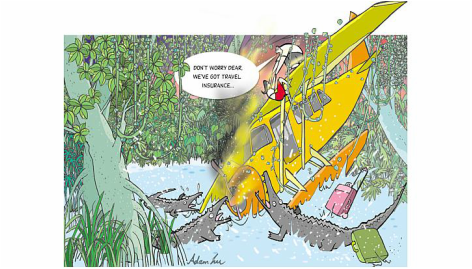
4. What to consider when buying travel insurance By Joan Chew
Consumers should consider their needs and expectations when they purchase travel insurance products. Mr Ignatius Chng, who heads travel insurance and related services at AIG, provides this checklist of questions for travellers:
Comprehensive travel insurance products provide benefits, such as reimbursement of medical expenses (overseas and local), medical evacuation or repatriation expenses, compensation for accidental death and permanent disability, trip cancellation or curtailment, travel delay, loss of personal belongings and even unused portions of entertainment tickets (such as those for theme parks, concerts and football matches) which the insured person was unable to use due to the coverage of the policy.
Supplementary topic published in Army News issue 230 Dec 2014
How to avoid getting stranded overseas by Brandon Leow
If you lose your passport overseas
It is also well worth having a photocopy of your passport with you when you travel, which you can pack in your suitcase. This will certainly help with identification if you should lose your passport and other important documents such as your NRIC or 11B at the same time.
For those who are worried about identity theft, the ICA will immediately cancel the passport, update its database and convey the relevant information to Interpol, the moment a passport is reported as missing. This prevents use of that particular passport even if it should be recovered later on.
Article 1st published on 28 Nov 2014,
edited on 30 Dec 2014
by Benjamin Cheah
Consumers should consider their needs and expectations when they purchase travel insurance products. Mr Ignatius Chng, who heads travel insurance and related services at AIG, provides this checklist of questions for travellers:
- How frequently do you travel?
- Do you travel alone or with your family?
- Where are you travelling to? Is there good access to medical facilities and what is the cost of medical treatment there?
- Do you have any health issues?
- Purpose of your trip - is it for business or leisure?
- What do you expect from the insurance coverage?
- What does the travel insurance cover?
Comprehensive travel insurance products provide benefits, such as reimbursement of medical expenses (overseas and local), medical evacuation or repatriation expenses, compensation for accidental death and permanent disability, trip cancellation or curtailment, travel delay, loss of personal belongings and even unused portions of entertainment tickets (such as those for theme parks, concerts and football matches) which the insured person was unable to use due to the coverage of the policy.
Supplementary topic published in Army News issue 230 Dec 2014
How to avoid getting stranded overseas by Brandon Leow
If you lose your passport overseas
- Immediately report its loss to the nearest police station and request for a copy of the report if possible, if not request for an acknowledgement slip or receipt (within 14 days)
- Report the loss to the nearest Singapore mission, bringing with you the relevant documents necessary which would be proof of Singapore citizenship, the passport sized photograph and the copy of the police report
- Document of Identity which will facilitate your return to Singapore. Following that, you must proceed to the Citizens Services Centre at the Immigration and Checkpoints Authority of Singapore (ICA) building to make your new passport
It is also well worth having a photocopy of your passport with you when you travel, which you can pack in your suitcase. This will certainly help with identification if you should lose your passport and other important documents such as your NRIC or 11B at the same time.
For those who are worried about identity theft, the ICA will immediately cancel the passport, update its database and convey the relevant information to Interpol, the moment a passport is reported as missing. This prevents use of that particular passport even if it should be recovered later on.
Article 1st published on 28 Nov 2014,
edited on 30 Dec 2014
by Benjamin Cheah
